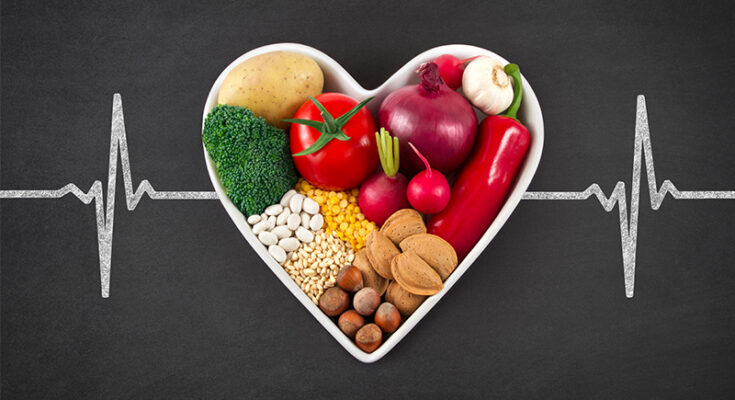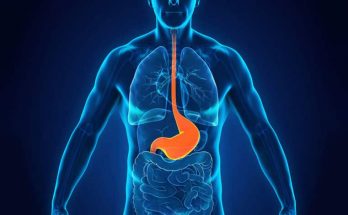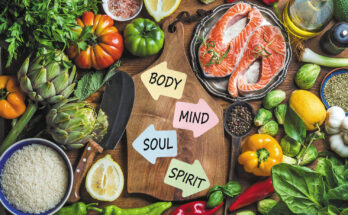Healthy Diet
A healthy diet is an important way to maintain heart health. Over the next few minutes, we’d like to share answers to some of the most commonly asked questions about heart-healthy eating.
I have high cholesterol. Should I stay away from high-cholesterol foods like eggs and
shellfish?
Cholesterol in your food actually has very little effect on your blood cholesterol. This is because your liver makes most of the cholesterol in your body. What affects your blood cholesterol most is the amount and type of fat that you eat. The best way to lower your blood cholesterol is to choose foods that are lower in fat.
Choose leaner cuts of meat, skinless poultry, and lower-fat dairy products, and limit egg yolks, the yellow part of the egg, to 3 per week maximum.
Shellfish, like shrimp and squid, are a low-fat alternative to eating meat and can be enjoyed once a week. Scallops, mussels, lobster, and crab are very low in cholesterol and can be enjoyed as often as you like.
Healthy Diet
There are a lot of different diets out there. Should I really be limiting my fat intake?
Fat has an awful lot of calories. Limiting your fat intake,
as long as you’re not replacing the calories with unhealthy calories can be helpful for
achieving and maintaining healthy body weight.
The type of fat you eat can also affect your cholesterol levels. Saturated fats and trans
Healthy Diet
fats can raise your LDL cholesterol or lousy cholesterol. Foods that have saturated
fats typically come from animal sources, so meats and dairy products generally have the
highest amounts of saturated fats.
Make sure to choose lean cuts of meat and skinless poultry, and trim your meat of any
visible fat.
Enjoy low-fat dairy products, like skim or 1% milk and 0% yogurt
Trans fat is primarily found in commercially processed foods. This type of fat is worse
for your heart than saturated fat, so it’s important to choose foods that are trans-fat-free
Healthy Diet

.
Before buying any commercially processed foods, check the packaging to make sure it doesn’t
have any trans fat in it.
Look for phrases like “trans-fat free”, “0 trans fat”, or “no trans fat”
Check the ingredient list – make sure that “shortening” or “partially hydrogenated
oil” are not listed as ingredients. If they are, pick a product that doesn’t have these
two ingredients listed.
Avoid using hard margarine, which is high in trans fat. Instead, use a non-hydrogenated
margarine, which is trans-fat free and has very little saturated fat.
What’s the best oil to cook with?
Cooking oils are a good source of healthy fats called unsaturated fats. The best oils
to use in your cooking are olive oil and canola oil.
Even though these are healthy oils, it’s still important to limit the amount of oil
that you use when you’re cooking. Use heart-healthy cooking methods that don’t need
a lot of oil
Such as steaming, poaching, baking, roasting, and stir-frying. Avoid deep-frying or pan-frying.
Even if you are using a heart-healthy oil, your food will absorb too much extra oil during
the cooking process.
When you are adding oil to your cooking, use an oil spray or measure out the oil that you’ll
be using.
I’ve heard a lot about omega-3 being good for my heart, but I’m not really sure what
it is. Can you tell me more about it?
Omega-3 fats are healthy fats that we need to get from food because our bodies can’t
make them. We need them to help raise our healthy cholesterol and make our blood vessels
more elastic.
The best sources are from fatty fish including salmon, tuna, trout, mackerel, herring, and
sardines. You can choose fresh, frozen, or canned fish. When you choose canned fish,
Healthy Diet
make sure it’s packed in water instead of oil. You should try to eat these types of
fish at least twice a week.
If you don’t eat fish, you can also get omega-3 from walnuts, ground flax seeds, chia
seeds, pumpkin seeds, and wheat germ. You can enjoy these nuts and seeds every day, but
make sure that they’re unsalted and haven’t been pre-roasted in oil.
I know that fruits and vegetables are healthy. Should I be focusing on anything else?
Fruits and vegetables are packed with vitamins and minerals, and they’re also a great source
of fiber. Fiber can help to decrease your cholesterol and blood pressure. It also helps
you to feel full for longer, which helps with achieving and maintaining healthy body weight.
Of course, fiber is also useful for keeping your bowels regular.
There are two kinds of fiber: Soluble fiber which is especially helpful for lowering cholesterol
and blood pressure; and insoluble fibre which helps to keep your bowels regular. It’s important
to ensure
you get both kinds of fiber every day.
Foods that are rich in soluble fiber include psyllium, oat products like oatmeal and oat
bran, legumes, and certain fruits and vegetables like apples, pears, berries, citrus fruit,
broccoli, cauliflower, and squash.
Insoluble fiber is also known as “roughage”, and can be found in whole grain pieces of bread, cereals
and portions of pasta, leafy vegetables like spinach and lettuce; and more colorful fruit and
vegetables like melons and peppers.
If you’re not used to eating a lot of fiber, start slowly, and make sure to drink plenty
of water to help prevent stomach upset.
I don’t have diabetes, do I still need to watch my sugar intake?
Sugar can be found naturally in food, or it can be added to food. Sugar is found naturally
in foods like fruit and milk products. These foods are healthy and should be enjoyed throughout
the day.
Added sugars include table sugar, honey, syrups and foods that contain added sugars, such
as sugar-sweetened beverages, desserts, and sweetened cereals.
Eating large quantities of added sugars can increase weight and increase the risk of developing
heart disease, even in people who are not overweight
So, it’s important to limit the amount of added sugars that you eat. Having an occasional
treat is fine, just remember that if you have a treat every day, it’s no longer a treat,
it’s a habit. I think I need to cut down on my salt intake.
How do I do that?
Salt contains sodium, and eating too much sodium can increase your blood pressure. Sodium
is found naturally in fresh foods, but more than 75% of the sodium we eat comes from processed
and packaged foods.
To cut down your sodium intake, limit the amount of salt you eat by not adding any to
your food at the table.
When you’re cooking, only add a pinch of salt,
or instead of salt, try adding flavor with dried or fresh herbs, such as basil, thyme,
or rosemary, or try using a blend of herbs and spices.
Choose fresh foods whenever possible, and limit foods that have been processed, pickled,
smoked, or salted
If you are using canned products, make sure to rinse them well underwater first
The foods I eat are healthy, but I’m just not sure how much to eat. Can you tell me
more about heart-healthy portion sizes?
Portion control is important for achieving and maintaining healthy body weight.
A simple way to do it is to follow the plate method. Fill up half of your plate with vegetables.
A quarter of your plate should include lean protein like fish, legumes, skinless poultry, or lean meat. The last quarter of your plate should be high-fiber starchy foods like whole-grain pieces of bread, brown or wild rice, multi-grain pasta, potatoes with their skin still on,
or corn. Then you can round off your meal with a glass of milk and some fruit for dessert.
Not every meal will fit into the plate method. What do you do on pizza night? Yes, there
can still be pizza night. Just apply the same ideas.
Choose a pizza made with a whole-grain thin crust and topped with lots of veggies and
some grilled chicken. Let that fill up half your plate. Then, have a big salad with it and enjoy some fruit for a sweet finish.
What are some heart-healthy tips for eating out?
When eating out, choose dishes that have been prepared using heart-healthy cooking methods.
These include dishes that are steamed, poached, broiled, grilled, stir-fried, or baked.
Choose dishes with lean cuts of meat, skinless poultry, fish, or legumes.
Choose dishes with higher fiber starch options, such as whole wheat or multigrain pasta, brown
or wild rice, and sandwiches made with whole-grain pieces of bread.
Ask to have your salad dressings and sauces on the side. Choose non-creamy dressings and
sauces.
And of course, don’t forget the veggies!
We hope these tips will help you make heart-healthy eating part of your lifestyle and
daily routine.
If you have any additional questions, please don’t hesitate to let a member of your health
care team knows that you’d like to speak with a registered dietitian.



